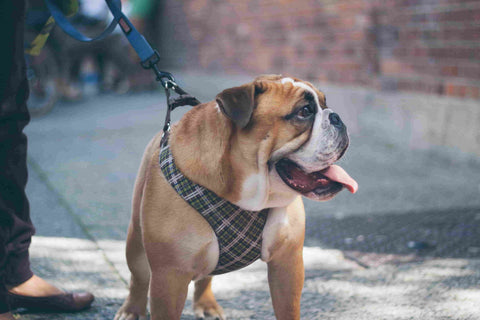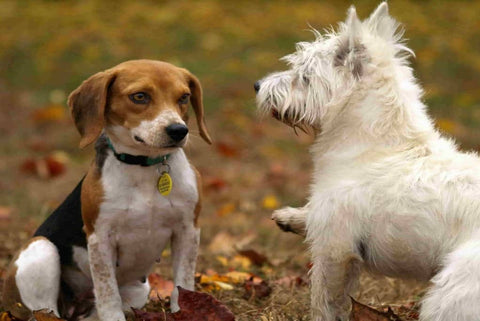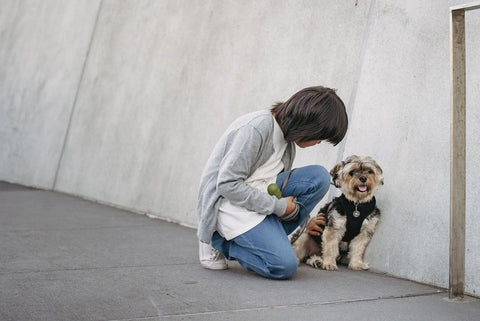What's the Best Harness for a Dog Who Lunges?
While a dog’s energy is something distinct to them, it makes them lovable pets but sometimes, it can be too much to handle.
Suppose you have a dog who loves to lunge at other dogs or people while on walks; you know how frustrating it can be. It is unsafe, but it can also be challenging to keep your dog under control. A properly fitting dog harness can help reduce the risk of your dog getting loose and help to make walks more enjoyable for both you and your pup.
How to Choose the Right Harness for a Lunging Dog
Prioritize Front-Clip & Dual Cip Options
A front-clip type of harness is the best harness for dogs that lunge where an attachment for the leash is located in the middle of the dog's chest area.
Because of this strategic design, instead of the dog's neck being tugged in a collar, the pull affects the dog toward you, thus stopping them from moving forward.
If they insist on pulling away, they get turned towards the handler instead of moving away from you. This is the effect we want to get.
Soon after that, the dog learns that it would be futile no matter how hard it may try to move, so they stop altogether. Now, the problem is solved.
Choose a Harness with a Handle
This will give you greater control when there is an attempt but prevents a dog from lunging. A well-fitting harness with a handle will also help to distribute the weight of your dog evenly, making it more comfortable.
Get the Right Size
It is essential to get the right size when lunging dogs because it can help prevent injuries. If the dog is too small, it may escape. Conversely, if the dog is too large, it could pull or jerk you and your dog.
Consider Other Important Features
When choosing the best harness for dogs that lunge, you should also consider:
- Adjustable Straps
- Easy to Put On & Off
- Lightweight
- Soft Padding
- Breathable Material
- Reflectible Strips
- Easy to Clean
Ensure a Proper Fit
This means that the collar or harness you use should fit snugly and not loose. To determine whether the fit of the harness is alright, the two-finger rule should be remembered. This helps to keep a dog from lunging on leash.
Why Dogs Lunge?
Dogs lunge for several reasons—the most common cause is fear and frustration. When a dog feels scared or threatened, they may lunge as a way to protect themselves or they may also be frustrated if they feel trapped or unable to escape from a situation.
Another common reason for lunging is excitement which can happen when a dog sees another dog or person they want to play with. They may also become excited if they smell something interesting or see something moving that they want to chase after.
The last common reason for lunging is aggression which usually happens when a dog feels threatened or challenged by another animal or person.
The other less common, but possible reasons include:
- Insecurity
- Natural instincts to chase prey
- Desire to seek conflict
- Outdoor stimuli (other dogs, animals, cars, bikes, people, among others)
How to Stop a Dog from Lunging on a Leash
First, understand the root of lunging. Lunging can be dangerous for both the dog and the person they're lunging at. It's essential to get to the root of the problem so that you can help your dog learn how to control their impulses.
The second is management. Create a plan to address to stop the dog from lunging. It’s best to consult with a professional who can help you figure out the cause and create a plan to address it.
Lastly, use the right accessory. The best harness for a lunging dog is a harness with a front-clip harness. It will put pressure on your dog's chest and help turn them back toward you when your dog jolts toward the stimulus target which stops the dog from lunging.
Choose the Correct Equipment for Your Fido
When out on walks or runs with your dog, it is essential to have the proper equipment. This includes a good leash and harness that fit well and are comfortable for you and your pup. Different leashes and harnesses may work better depending on your dog's size and breed.
Manage the Dog's Behavior
Get your dog in the presence of their trigger but far enough to prevent them from lunging, and try to build a positive association when staying nearby the trigger—it can be engaging play, tasty treats, etc. Move a bit closer to the trigger and repeat the process until your dog learns not to react to it. Plan your walks to avoid the triggers, and monitor the environment.
Train Your Four-Legged Friend
One technique on how to stop a dog from lunging on a leash is to teach the incompatible alternative behavior with the commands: "Watch me," "Stop," "Sit," "Touch," etc.
Distract Your Dog When Trigger Is Nearby
Use the commands, treats, or favorite toys to get your dog's focus on these tricks instead. This prevents a dog from lunging.
Get The Perfect Harness for a Lunging Dog From Pet&Cuddle!
As any dog owner knows, one of the most frustrating things can be how to stop a dog from lunging on a leash. It is difficult to control your dog in these situations, but it can also be dangerous for you and your pet.
At Pet&Cuddle, we offer the perfect solution: our dog harness with a front clip that initiates the “no pull” feature. This innovative design helps train your dog not to pull or lunge by creating an uncomfortable feeling whenever they try to do so. But don't worry - it won't hurt them, and as soon as they stop putting pressure against the harness, they'll be perfectly comfortable again.
So if you're looking for a top-quality harness that will help keep a dog from lunging on a leash, be sure to choose Pet&Cuddle! We have a lot of options to choose from our latest dog harness and retractable dog leashes collection.
Questions About Using Harnesses for Lunging Dogs
Still, have doubts in your mind as to how to prevent a dog from lunging? We answer the commonly asked questions about the topic.
Is a harness better for a reactive or aggressive dog?
A good option is the best harness for a lunging dog that is reactive or aggressive. This is because a harness can help give you more control over your dog and prevent them from pulling or lunging. A harness can also help distribute the force of a pull more evenly, which can help prevent injuries.
Do dog harnesses promote pulling?
The answer to this question depends on many factors, including the type of harness used and how it is used. Others can help to reduce or eliminate it particularly, a front-clip type of harness.
This helps redirect your dog's attention and discourages them from pulling on the leash. There are also many different types of no-pull harnesses available, effectively reducing or eliminating pulling behavior.
How do I stop my dog from reactive lunging?
The first step is to identify what is causing your dog to lunge. Is it another dog? A person? A car? Once you know what the trigger is, you can begin to work on desensitizing your dog to that stimulus through leash reactivity training.
How to stop your dog from lunging at other dogs is to start walking him in areas with a few other dogs. If he begins to lunge, turn and walk in the opposite direction. As he becomes more comfortable around other dogs, you can introduce him to them in a controlled setting, such as doggy daycare or dog parks.
If your dog is lunging at people, start by walking him in areas with few people. If he begins to lunge, turn and walk in the opposite direction. As he becomes more comfortable around people, you can start to introduce him to them in a controlled setting, such as obedience class or doggy playgroups.
Why are front clip harnesses better for lunging dogs?
A front-clip harness is an excellent option if you're looking for a harness to help your dog with lunging. Here's why:
- Front clip harnesses provide more control. With a front clip harness, the leash attaches to a ring located at the front of the harness, near the dog's chest. This design gives you more control over your dog's movement, making it easier to keep them from lunging forward.
- Front clip harnesses can help discourage pulling. Because front clip harnesses provide more control, they can also help prevent pulling. When your dog tries to pull ahead, the pressure on its chest will cue them to slow down or stop. This will solve your dilemma on how to stop your dog from lunging at other dogs.
- Front clip harnesses are less likely to cause choking. Back-clip harnesses attach the leash to a ring located at the back of the harness, near the dog's shoulders. If your dog pulls while wearing one of these harnesses, they can easily choke themselves.




